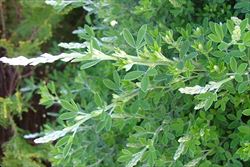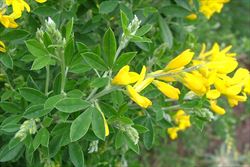Click on images to enlarge

habit (Photo: Sheldon Navie)

habit (Photo: Sheldon Navie)

leaves and flower buds (Photo: Sheldon Navie)

close-up of younger stem and leaves with three leaflets (Photo: Sheldon Navie)

elongated flower clusters (Photo: Sheldon Navie)

close-up of pea-shaped flowers (Photo: Sheldon Navie)
Scientific Name
Genista stenopetala Webb & Berthel.
Synonyms
Cytisus maderensis (Webb & Berth.) Masf.Cytisus stenopetalus (Webb & Berth.) ChristGenista maderensis (Webb & Berth.) Lowe (misapplied)Teline stenopetala (Webb & Berth.) Webb & Berth.
Family
Fabaceae (Queensland, the ACT, Victoria, Tasmania, and the Northern Territory)Fabaceae: sub-family Faboideae (New South Wales)Leguminosae (South Australia)Papilionaceae (Western Australia)
Common Names
leafy broom, leafybroom, Madeira broom, narrow-petalled broom
Origin
Native to the Madeira and Canary Islands (i.e. La Palma and Tenerife).
Naturalised Distribution
Occasionally naturalised in some parts of south-eastern Australia (i.e. in south-eastern South Australia, southern Tasmania, near Sydney in the coastal districts of central New South Wales and near Melbourne in southern Victoria).
Also naturalised in New Zealand and south-western USA (i.e. California).
Notes
This species is currently regarded as a minor environmental weed or "sleeper weed" in south-eastern Australia. It is relatively widely naturalised, but is nowhere near as abundant or widespread as the other important broom species. However, it is easily mistaken for Cape broom (Genista monspessulana) and may be more common and problematic than is currently recognised.
Madeira broom (Genista stenopetala) has been widely grown as a garden ornamental in the temperate regions of Australia. It has escaped cultivation and at present is a minor weed of urban bushland, pastures, open woodlands, disturbed sites, waste areas, watercourses and roadsides. It has occasionally also been recorded in conservation areas (e.g. in McKay Reserve in Pittwater in New South Wales and in Tasman National Park in Tasmania).

